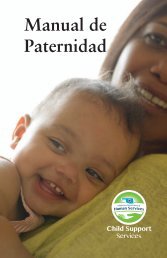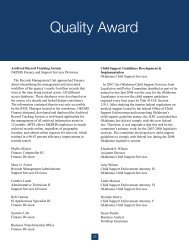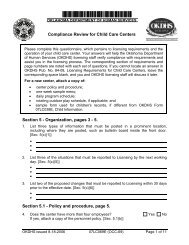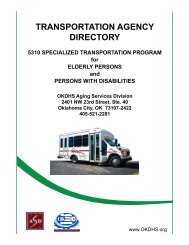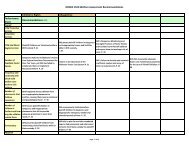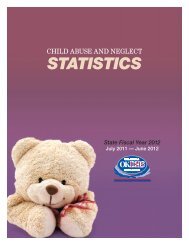The Oklahoma Pinnacle Plan - Oklahoma Department of Human ...
The Oklahoma Pinnacle Plan - Oklahoma Department of Human ...
The Oklahoma Pinnacle Plan - Oklahoma Department of Human ...
You also want an ePaper? Increase the reach of your titles
YUMPU automatically turns print PDFs into web optimized ePapers that Google loves.
<strong>The</strong> <strong>Oklahoma</strong> <strong>Pinnacle</strong> <strong>Plan</strong>:<br />
An Improvement <strong>Plan</strong> for Child Welfare Services<br />
APPENDICES<br />
March <br />
2012<br />
Steib, Sue Casey Family Programs SSteib@casey.org<br />
Steyn, Jackie YWCA-Domestic Violence jsteyn@ywcaokc.org<br />
Tate, Sue <strong>Oklahoma</strong> CIP Sue.Tate@oscn.net<br />
Williams, Sheamekah ODHMSAS SXWilliams@odmhsas.org<br />
Training and Development (Staff and Placement Resources)<br />
<strong>The</strong> Training and Development portion <strong>of</strong> the Implementation <strong>Plan</strong> covers topics such as types <strong>of</strong><br />
trauma; impact <strong>of</strong> trauma across domains; effective management <strong>of</strong> trauma; and methods to address<br />
trauma in client populations and system members (Secondary Traumatic Stress). It includes training and<br />
support for staff, resource families, birth parents and placement providers.<br />
Staff:<br />
<strong>The</strong> NCTSN’s Child Welfare Trauma Training Toolkit is being used as the basis for staff training on<br />
trauma. This training will be on-going and all staff will have completed the training by March 31, 2013.<br />
Training for Trainers (TOT) was provided by the Chadwick Center in August 2011. <strong>The</strong> TOT group<br />
included staff identified by each <strong>of</strong> the six geographic agency management Areas, Children and Family<br />
Services Program staff, Mental Health partners/providers, and OKDHS contracted trainers. Each TOT<br />
participant committed to provide at least two training sessions.<br />
Child welfare program staff and mid-level managers (child welfare field liaisons) participated in the<br />
Trauma Toolkit training on September 27-28, 2011. <strong>The</strong> two-day training concluded with small group<br />
discussion about planned program-related rollout. <strong>The</strong>se discussions must be ongoing and purposeful<br />
and will be addressed in the Communication piece <strong>of</strong> the Implementation <strong>Plan</strong>.<br />
<strong>The</strong> Trauma Toolkit training will be rolled out with an area-specific methodology, so that each area<br />
develops a training plan for its staff. <strong>The</strong> CTISP State Project Lead developed and provided a planning<br />
document for areas to use in outlining area-specific training plans, needed supports and needed<br />
resources. <strong>The</strong> Trauma-Informed Care Learning Collaborative Lab Sites (Custer, Jackson/Greer,<br />
<strong>Oklahoma</strong> 55A, Pontotoc, Okmulgee, and Tulsa Counties) are the target for the initial Trauma Toolkit<br />
training in each area. Providers and tribal partners will be invited to the Trauma Toolkit training sessions<br />
as they are presented in areas. Training will be mandatory for all OKDHS child welfare staff and will<br />
include:<br />
an online workspace to provide ongoing trainer support, monitor training roll out, report<br />
successes and identify needs;<br />
completion <strong>of</strong> a survey to identify partners in the community to assist with training;<br />
secured resources and the development <strong>of</strong> a resource list and resource library to identify<br />
resources needed;<br />
monthly trainer calls to provide trainers with support and to share information;<br />
web-based trainer sharing format which has already been developed; and<br />
as additional funding becomes available:<br />
o expansion <strong>of</strong> trainer support;<br />
o development <strong>of</strong> a Trainer Support Day when trainers can come together to discuss<br />
lessons learned and share success;<br />
o the purchase <strong>of</strong> additional resources; and<br />
o the purchase <strong>of</strong> specific supports needed, including flash drives, speakers, etc.<br />
Appendix C – Trauma-Informed System Implementation <strong>Plan</strong><br />
- 21 - | P a g e




